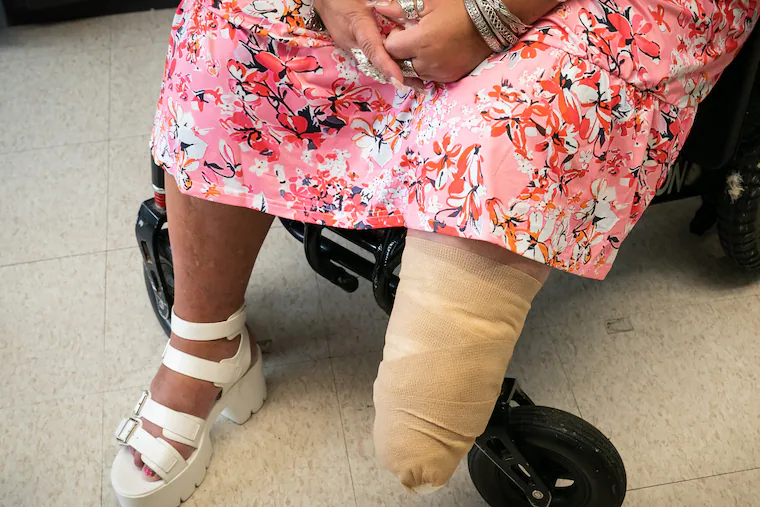
The spread of fentanyl laced with xylazine, an animal tranquilizer, is fueling America’s latest chapter of the opioid crisis. The lethality of fentanyl is well known, but the rise of xylazine and its gruesome effects on the limbs and lives of those who use drugs is only recently coming into focus. Unfortunately, the inconsistent and uncoordinated responses from government agencies are failing those most at risk.
Emergency rooms across the Philadelphia metro area are seeing a rise in grisly limb-threatening necrotic wounds caused by the injection of the illicit combination, which is also known as “tranq dope” or “zombie drug.” It results in the breakdown of skin, muscle, and even bone, potentially resulting in large wounds that compromise limb function and often lead to amputations.
The causative agent, xylazine, is known, but efforts to schedule or regulate xylazine at the federal level have been disappointingly slow. The Office of National Drug Control Policy designated fentanyl adulterated with xylazine as an “emerging drug threat” in April 2023.
But today, nearly two and a half years after that warning, xylazine still has yet to be classified as a controlled substance. This has allowed traffickers to acquire the drug from overseas — particularly from China — where it is sold as powder and liquid that enter U.S. supply chains, sometimes diverted from veterinary sources. The U.S. Department of Justice recently announced indictments against some foreign manufacturers, but the trafficking route remains active.
In July 2023, federal officials issued a “National Response Plan” outlining enhanced testing, data collection, harm reduction, and scheduling measures. However, the plan’s goals — such as reducing xylazine-positive overdose deaths by 15% in three out of four census regions by the end of the year — highlight the disappointingly slow federal response, and the government’s meager goals to curb the increasing risk to public health.
States’ responses to the fentanyl-xylazine crisis are inconsistent, as well: New York, Pennsylvania, and Massachusetts have passed laws to criminalize xylazine possession and quickly schedule the drug, tightening supply, but raising concerns about unintended consequences for veterinary medicine and people who use drugs.
This is a public health crisis that requires federal leadership and state coordination.
Conversely, states like Maryland and Rhode Island have focused on harm reduction, investing in mobile wound care units, syringe exchanges, and outreach programs that directly serve affected populations. Meanwhile, states such as Texas and Indiana have been slower to expand either treatment or harm reduction efforts, concentrating more on interdiction and law enforcement, with fewer medical resources allocated to treat overdoses or wounds.
This uneven approach by states — and lack of direction and necessary regulation at the federal level — means support for patients and clinicians varies more by location than by need. Worse, there is every reason to believe this new chapter of the opioid crisis will quickly expand beyond Philadelphia to other urban — and ultimately rural — regions across America, severely burdening their healthcare systems.
This is a public health crisis that requires federal leadership and state coordination.
On the front lines in Philadelphia, physicians have observed the damage worsening as xylazine-laced fentanyl becomes the street drug of choice. Unlike other opioids, this combination causes wounds so severe that traditional treatments often fall short, and standard reversal with agents like naloxone is ineffective.
» READ MORE: Addiction takes a toll on life and limb
Patients arrive in emergency rooms with necrotic limbs, infections that resist antibiotics, and wounds that extend well beyond injection sites — warranting highly expensive, complex, and protracted medical and surgical care.
In response, the Rothman Institute Foundation for Opioid Research and Education organized a citywide symposium in November of 2024 in an effort to share experiences and best practices by physicians as well as to inform policymakers.
The result was the “Philadelphia Consensus” on how best to manage xylazine-associated wounds, recently published in the journal SurgiColl. This consensus paper provides an outline for a coordinated multidisciplinary approach for integrating addiction treatment, wound care, infectious disease input, surgical care, and the social realities faced by people who use drugs.
Central to the consensus is the determination that medical stabilization, addiction treatment, social support, and local wound care should precede any advanced surgical reconstruction. Successful management of xylazine-associated wounds is predicated on management of the addiction first.
The government’s regulatory and financial support is paramount to turning the tide. Our “Philadelphia Consensus” should set the national standard for care. But federal agencies need to lead with smart regulation, monitoring, resources, and, most importantly, restricting access to xylazine. State governments need to collaborate to ensure wound care, addiction treatment, and supportive housing are funded and accessible.
The risks and lethality of fentanyl are understood, but the compounding effects of xylazine and its resultant necrotic limb-threatening wounds are only now becoming more appreciated.
National and local leadership must rise to this new public health challenge directly and deliberately to save limbs and lives, and offer hope to those the epidemic is leaving behind.



